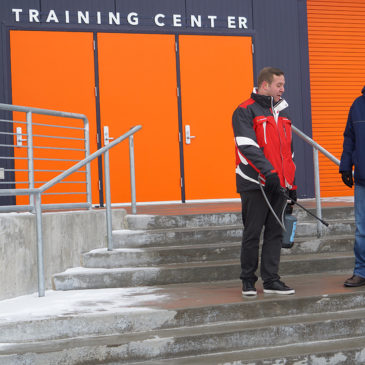As the variety of de-icing and anti-icing materials has grown in recent years, facility managers are tasked with balancing the plusses and minuses of the solutions available. Which are most effective – and most cost effective? What are the environmental impacts of the material used? How quickly and conveniently can the material be applied?
For most facility managers, a key consideration is how the de-icing and anti0icing materials impact the carpeting and flooring in their buildings. More than just an issue of appearance, when some materials are tracked into a building, they can cause permanent damage, increase maintenance costs – and pose a health risk to the building’s occupants and visitors.
Some of the most commonly used de-icing materials can cause permanent damage, leaving behind white residue that can dull the finish of wood floors and cause them to splinter. Carpeting can develop dry rot, fading the color.
When calcium and magnesium chloride-based products are tracked into a building, they coat floors with an oily residue that damages wax and urethane finishes. It also makes hard surface floors slippery, putting employees and visitors at risk for slip and fall injuries. These materials also degrade carpets by wearing out carpet fibers and attracting dirt.
To protect against floor and carpet damage, frequent upkeep is required during snow and ice events, which costs time and money.
An alternative to granular de-icing materials is formic technology-based liquid de-icers. Their neutral pH formulations eliminate tracking, reducing near-term labor costs associated with manual cleaning, estimated at $50 per entrance per day, according to the ISSA. In the long-term, this reduces the need for full strip and re-coats, which represents a significant financial investment.
It is understandable that the de-icing and anti-icing materials that are meant for outdoor use can be damaging to carpeting and floors when tracked indoors, but the salt residue left over from many products can also cause permanent damage to pavers, asphalt, concrete, masonry, decorative stone or other custom walkways and metal light fixtures and railings.
Calcium, sodium and magnesium granular chloride products are all hydroscopic, meaning they draw moisture from the atmosphere. If they seep into groundwater supplies or wash into lakes or streams, they reduce the available oxygen levels, harming aquatic wildlife. Salt-based ice melters may also erode soil, kill plants and burn grasses.
Formic technology de-icers are 100 percent chloride free and are readily biodegradable. They are safe for water, plants, concrete, asphalt, stone and metals.
Pedestrian Safety
While potential damage inside and outside is critical, we haven’t forgotten about the people – creating a safe environment for pedestrians. An important aspect of creating a safe environment is the time required to ensure safety. Granular de-icers take three to five minutes, often more, to achieve an acceptable melt.
By contrast, liquid de-icers based on formic technology quickly and reliably remove thin layers of ice and prevent new snow and ice from accumulating. In fact, some formic technology de-icers have a speed of melt of about 30 to 50 seconds by reducing the freezing point to temperatures as low as minus 60° F.
Cost-Effectiveness
Determining the cost-effectiveness of a de-icing material requires consideration of a number of factors: speed of melt (discussed above), amount of material required to create a safe surface and the physical application process itself.
Ease and speed of application combined with reduced transport and loading costs make using liquids extremely attractive from a labor perspective. Using granular products can be very labor intensive, slowing the application process and negatively impacting safety in high-traffic pedestrian areas. For example, on stairs, applicators have to carry heavy bags, spreading material by hand, and in larger areas and walkways, push spreaders are often utilized. Liquid applications are far more efficient. Liquid tanks fill quickly, and today’s spray applicator technologies are convenient and easy to use, providing for very precise application rates.
The low quantity of liquids required to produce an adequate melt combined with speed of application make most liquid de-iciers more cost-effective. Most users will achieve a lower application cost per 1,000 sq. ft. with liquids. And, because the liquid achieves a melt three times more quickly than granular products, it creates a longer-lasting and safer walking surface.
So, when deciding what kind of de-icing material to use this winter, check three boxes: a safe surface outside, and reduced damage, both inside and out.



